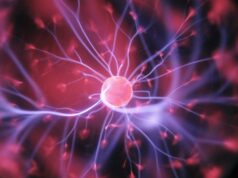In a study investigating the use of transcranial magnetic stimulation (TMS) for drug addiction, researchers at Medical University of South Carolina are the first to demonstrate that the noninvasive brain stimulation technique can dampen brain activity in response to drug cues in chronic alcohol users and chronic cocaine users. The findings are published in Biological Psychiatry: Cognitive Neuroscience and Neuroimaging.
Although the last 50 years of clinical and preclinical research have demonstrated that addiction is a brain disease, there are still no neural circuit-based treatments for substance dependence or the brain functions involved in the disorder. “Here, for the first time, we demonstrate that a new non-invasive brain stimulation technique may be the first tool available to fill this critical void in addiction treatment development,” said senior author Colleen Hanlon.
Elevated brain activity in response to drug cues–referred to as cue reactivity–occurs with many types of drugs, including nicotine, alcohol, marijuana, and cocaine. Cue reactivity also predicts relapse in addiction, so treatment approaches targeting the neural circuitry related to cue reactivity may directly impact cue-induced relapse in patients.
“Therefore, these results have a tremendous potential to impact both basic discovery neuroscience as well as targeted clinical treatment development for substance dependence,” said Hanlon.
First author of the paper Tonisha Kearney-Ramos, and colleagues performed two independent studies at the same time, one involving 25 people with cocaine use disorder and the other involving 24 people with alcohol use disorder. The participants received one session of TMS, which targeted magnetic stimulation to circuitry critical for drug-taking behaviours–the ventromedial prefrontal cortex. The real stimulation session was compared against a sham session that mimicked the experience of receiving TMS without actual brain stimulation.
Brain imaging before and after TMS revealed that when alcohol users viewed images of alcohol-related cues, such as a liquor bottle, the single TMS session significantly reduced their drug cue reactivity. The same was true for cocaine users when viewing images of cocaine-related cues.
“Since cue reactivity has previously been associated with abstinence, these studies suggest a common mechanism for treatment effects across disorders, with fMRI serving as a promising neural readout of treatment effects,” said Cameron Carter, Editor of Biological Psychiatry: Cognitive Neuroscience and Neuroimaging.
However, it is still unclear if the changes in brain activity observed in the study will translate to reduced drug or alcohol use. The participants did not report any changes in their drug or alcohol craving after TMS. The authors think that repeated sessions of the targeted stimulation may be needed to see changes in self-reported craving. The researchers hope to answer this question in an ongoing clinical trial involving multiple TMS sessions in cocaine users.
In addition to substance abuse, elevated cue-reactivity is a core symptom of many diseases, such as post-traumatic stress disorder, generalised anxiety disorder, traumatic brain injury, smoking, and obesity, said Hanlon. “Therefore, the treatment described in this manuscript may have implications far beyond the substance abuse field.”













